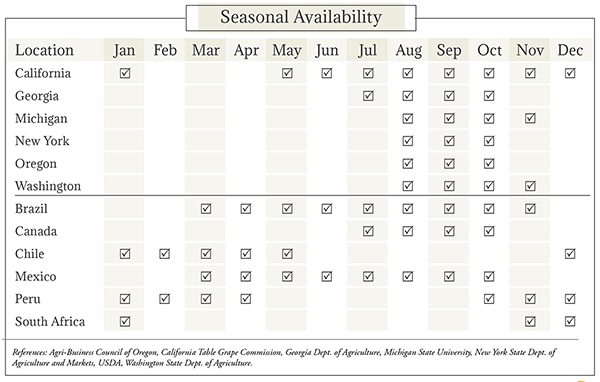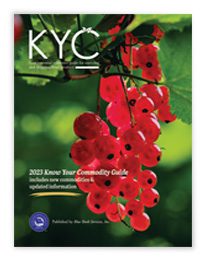Grape Market Summary


Image: Aripai Leangphet/Shutterstock.com
Grape Market Overview
A member of the Vitaceae family, grapes can be classified into an estimated 11 distinct genera and 600 different species. In addition to this vast diversity, grapes are one of the oldest cultivated plants dating back as far as 6,500 B.C. Spanish colonizers are credited with bringing grapes to the Americas, but multiple native species (including V. labrusca, V. aestivalis, V. riparia, and V. berlandieri) are notable for their stronger, muskier aroma. The popular contemporary cultivar, Concord, is a descendant of V. labrusca. The oldest grapevine in America is a 400-year-old muscadine vine located in North Carolina. Highly versatile, grapes are consumed as fresh, dried (as raisins), or processed into jam, juices, or wine. They can vary vastly in flavor as well as color—from black, blue, blue-black, and purple to red, green, and golden. California dominates U.S. production, exporting to Mexico (and throughout the world); in turn, Mexico augments U.S. supply from May through October. Chile and Peru contribute to U.S. supply as well, shipping from October through May.Types & Varieties of Grapes
Grapes are classified by type as American, European, juice, and muscadine. American grapes can tolerate varied climate. Cultivars able to tolerate cooler climates include Buffalo, Concord, Catawba, Edelweiss, Emerald, Golden Muscat, Niagara, and Steuben. European and European-hybrids lack cold hardiness, are thin skinned, and better suited to a warmer climate. Well known varieties include Champagne, Cotton Candy, Flame Seedless, Scarlet Royal, Sugraone, and Autumn King. Any variety of sweet grapes can be made into grape juice although the most common is Concord. Muscadine grapes, which grow wild in North Carolina and much of the Southeast, are considered native to the Americas. Some varieties are not recommended for certain regions. For instance, grape varieties such as Jupiter, Saturn, and Sunbelt can be susceptible to Pierce’s disease (see below for further information) and should not be grown in areas where the disease has been a significant threat.
Cultivation of Grapes
Grapes require fertile, well-drained soil, and ample sun. Vines can last 15 to 30 years depending on location and care. When planting, supported (trellised) vine rows should be 6 to 8 feet apart to allow for sufficient canopy growth and air flow. Vines require pruning to produce large clusters but climate, variety, irrigation, and weed control also factor into the equation. Planting into black plastic mulch can help with weeds and better maintain soil temperature. Netting and noise makers will help keep wildlife, especially birds, away from fruit near harvest. Birds will feed as acid falls and sugar content rises, so control measures should be in place before brix levels accelerate. Harvesting is labor intensive and requires careful planning by variety and, of course, intended use. Bunches are ready when grapes at the tip of clusters (the last to mature) are sweet. Grapes will not ripen after harvest.Pests & Diseases Affecting Grapes
Phylloxera is an insect that kills grapevine roots by laying eggs on rootlets (muscadines are resistant/tolerant). Grape berry moth larvae feed on blossoms and berries, though insecticides should not be applied until after the grapes have reached the size of small peas or beneficial pollinators will be harmed. Grape leafhoppers feed on the underside of leaves resulting in stippling. Because they are so small, these insects can do serious damage before their presence becomes known. Other pests include banded grape bugs, borers (cane, corn, root), cutworms, various types of beetles, hornets, mealybugs, mites, plume moths, rootworms, spotted wing drosophila, and thrips. Fortunately, Muscadine grapes have the chemical resveratrol that provides protection from some pests and diseases. Pierce’s disease is spread through infected insects as they feed on vines. Some varieties are tolerant of the disease (for instance, muscadine) but susceptible varieties will experience vine death as there is no treatment. Powdery mildew causes lesions on vines, leaves, and fruit with a characteristic powdery white or grey coating. Fungicides, both commercial and organic, have been successful in preventing and controlling the disease, which can spread quickly by high humidity and a lack of sunlight. Downy mildew can infect leaves, shoots, and berries, beginning with lesions on upper surfaces and a white cottony growth underneath (powdery mildew can occur on both sides). If left untreated, defoliation and vine vigor can be affected along with ripening and berry yields. Black rot is spread by dried berries left on the vine or on the ground over winter. Removing dried berries from vines before winter is key to prevention. Anthracnose causes round holes in leaves and can be controlled by the same fungicides as black rot. There are several other types of rot, including bitter, fruit, ripe and sour rot. Other diseases of note include blight, botrytis, crown gall, dieback, leaf roll disease, leaf scorch, and red blotch.Storage & Packaging of Grapes
Once clipped, clusters are placed directly into vented bags or nesting lugs/bins for subsequent cooling and storage. Any defective berries should be removed to prevent leftover stems from spreading decay or disease. Wine grapes can be shaken off vines onto tarps for processing. Some juicing varieties are picked individually and not by the bunch due to maturity. This can be true for Muscadine grapes as well, which grow in loose clusters with berries falling to the ground when ripe. Grapes should be cooled and stored at 30 to 32°F with 90 to 95% relative humidity. As a low ethylene producer, grapes can be stored with other fruits and vegetables with the exception of those with strong odors like onions. Pouch bags and clamshells are the most prevalent packaging. References: California Rare Fruit Growers, California Table Grape Commission, Cornell University, PennState Extension, Texas A&M AgriLife Extension, USDA, Washington State University.
Grades & Good Arrival of Grapes
Table grapes are classified into six grades: U.S. Extra Fancy, U.S. Extra Fancy Export, U.S. Fancy Table, U.S. Fancy Export, and U.S. No. 1 Institutional. Fruit of all grades must meet basic requirements of being mature, firm, attached to the capstem, and not weak, shriveled, shattered, split, crushed, or wet. For Extra Fancy and Fancy grades, bunches must be fairly well filled and not excessively tight for the variety; stems must be well developed, strong, free from mold, decay, and freezing or other damage. Berries should be free from decay, waterberry, sunburn, almeria spot, and any other damage. For U.S. No. 1 Table and U.S. No. 1 Institutional, grapes follow basic requirements but have more latitude regarding bunches, stems, berries, and size.
Generally speaking, the percentage of defects shown on a timely government inspection certificate should not exceed the percentage of allowable defects, provided: (1) transportation conditions were normal; (2) the USDA or CFIA inspection was timely; and (3) the entire lot was inspected.
AMERICAN VARIETIES
| U.S. Grade Standards | Days Since Shipment | % of Defects Allowed | Optimum Transit Temp. (?) |
| 10-5-2 | 5 4 3 2 1 | 15-8-4 14-8-4 13-7-3 12-6-2 10-5-2 | 32° |
EUROPEAN VARIETIES
| U.S. Grade Standards | Days Since Shipment | % of Defects Allowed | Optimum Transit Temp. (?) |
| 12-4-1 | 5 4 3 2 1 | 15-6-3 14-6-3 13-5-2 13-5-1 12-4-1 | 31° |
Inspector's Insights for Grapes
- One of three commodities (kiwifruit and cantaloupes are the others) that require a minimum percent of soluble solids to meet U.S. No. 1 grade, the standard requires grapes be mature as defined by individual state regulations (e.g., Flame Seedless produced in California must meet a minimum soluble solids reading of 16.5% while Perlettes must meet a minimum 15.5%)
- Grapes affected by juice of adjoining leaking or decayed grapes are scored as a defect (called “wet and sticky berries” as a free-from defect, which will be scored against the tolerance for serious damage)
- Grapes wet from condensation are not scored as a defect
- Shattered berries are not attached to their capstem and are considered a defect; reasonable care should be taken when inspecting grapes as all shattered berries (including those that fell off during inspection) are scored as a defect; shattered berries affected by decay will be scored against the decay tolerance.
Grape Retail Pricing: Conventional & Organic Per Pound




